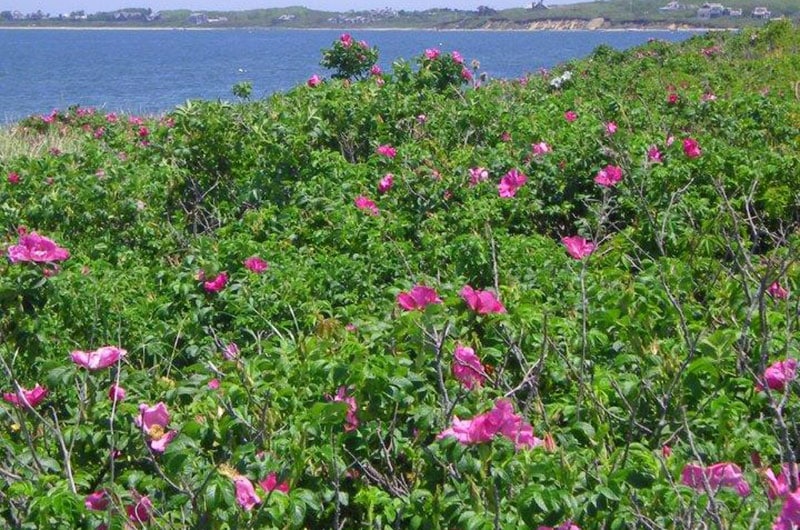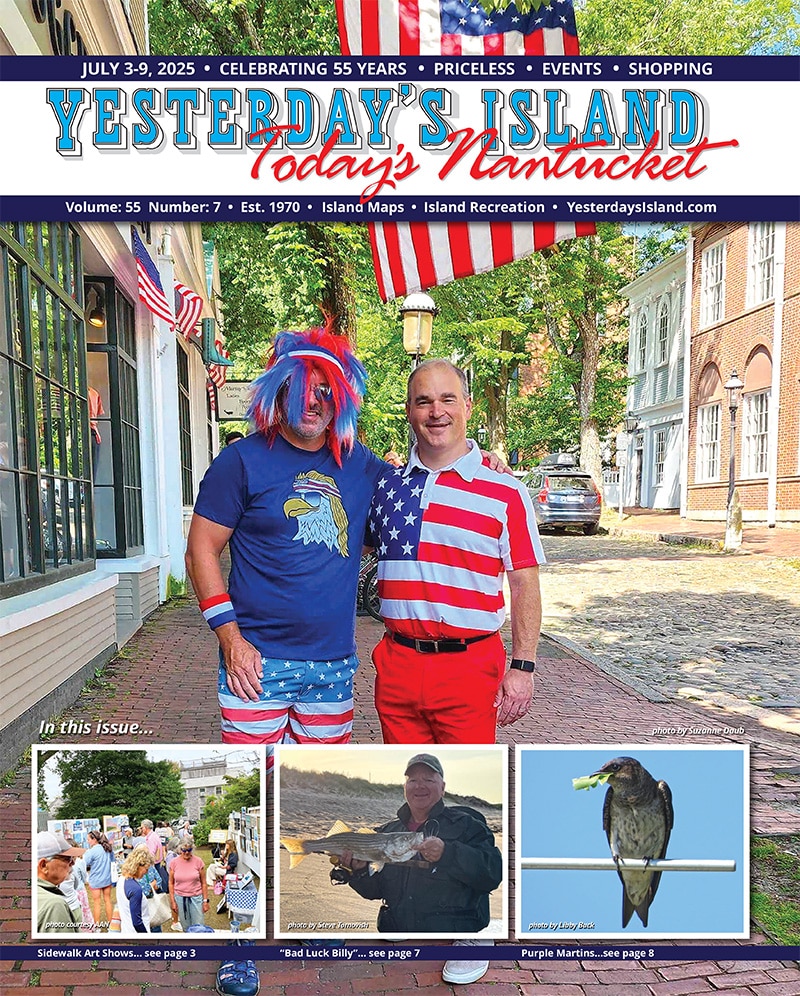~ by Dr. Sarah D. Oktay, Director, University of Massachusetts Nantucket Field Station ~
Whenever I write about invasive plants, usually when I am elbow deep pulling them up on a roadside or conservation land, I always think of the 1951 book and 1962 Movie “The Day of the Triffids” about a invasive of alien plants who land on earth and start taking over the world after a meteor has blinded the populace. The Triffids were mobile, deadly and carnivorous, very scary for a Saturday afternoon creature feature. Even today, the word “triffid” has become a popular British English colloquial term for large, overgrown or menacing-looking plants. Although the movie, TV shows, and radio shows took quite a bit of license from the book, I enjoyed them and the images have remained with me to this day.
Recently some of my colleagues from other biological field stations around the world joined me for an on island event at the Nantucket Hotel designed to help the public understand what a field station is all about. For the past year I have been the president of the Organization of Biological Field Stations (www.obfs.org). One of the biggest threats to field stations whether they are located in Spain or in Costa Rica or California or Oklahoma is from invasive exotic plants brought in by people or animals.
According to the Federal government, an “invasive species” is defined as a species that is 1) non-native (or alien) to the ecosystem under consideration and 2) whose introduction causes, or is likely to cause, economic or environmental harm or harm to human health. Invasive plants can be accidentally or deliberately introduced by means such as agriculture, as forage crops, as ornamentals or escapees from botanical gardens and estate gardens, through aquatic gardens, erosion control techniques, storms, or via hitchhiking pollen and seeds delivered by migrating birds. Human actions are the primary means of invasive species introductions. On Nantucket, the primary adverse effect perpetuated by invasive plants is ecological harm caused by habitat destruction as they out-compete other plants for nutrients, sunlight, water, and space. Some common invasive plants on island include: garlic mustard (Alliaria petiolate), Japanese knotweed (Polygonum cuspidatum), common reed (Phragmites australis) purple loosestrife (Lythrum salicaria), oriental bittersweet (Celastrus orbiculatus), Morrow’s bush honeysuckle (Lonicera morrowii), autumn olive (Elaeagnus umbellata), and multiflora rose (Rosa multiflora). – Black Swallowwort (Vincetoxicum nigrum) and spotted knapweed (Centaurea maculosa).
You may recall from previous articles that island science and conservations groups have banded together to form the Nantucket Biodiversity Initiative which provides small grant funds, logistical support and additional personnel to assist scientists on island in biodiversity related research. The Nantucket Biodiversity Initiative is a partnership between Nantucket conservation organizations, universities, non-governmental organizations, and individuals interested in documenting the biodiversity of the islands and adjacent waters and monitoring and conserving that biodiversity over time. A subcommittee of the Nantucket Biodiversity Initiative (www.nantucketbiodiversityinitiative.org) called the Invasive Plant Species Committee (IPSC) is working hard to control the expansion of exotic invasive plants on Nantucket while educating the public about their spread and effects on our island habitats. They have produced an excellent brochure entitled “Space Invaders: Weeds Gone Wild on Nantucket” that lists the top 10 highly invasive plant species of Nantucket and documents primary control methods and non-invasive alternative plantings. Some of these plants are also listed on the Massachusetts Invasive Plants Advisory Group’s website (www.massnrc.org/MIPAG) and some are uniquely destructive on Nantucket. They recently updated the brochure with new information on various plants that have become more or less problematic for the island.
Members of the IPSC include members representing the many conservation and research groups in the NBI and representatives from the Nantucket Garden Club and the Landscapers Association. We are on the lookout on Nantucket for extremely invasive plants that have been very problematic for the mainland. One of the top ten OMGs is mile-a-minute vine (Persicaria perfoliata) or mile-a-minute vine. An eagle eyed resident in Pocomo discovered one of these plants and quickly called me and I warned the other IPSC members. We want people to keep an eye out for this plant which has been known to grow up to six inches in 24 hours and with the efficiency of a super vine quickly covers other plants preventing them from getting enough sunlight to photosynthesize. If you go to www.nantucketbiodiversityinitiative.org and click on the Invasive Plant Species Committee link it will take you to the current list of Massachusetts and Nantucket invasive species and provide more information on Mile a Minute vine as well as listing contacts for reporting invasives. Fortunately, there are some very serious terrestrial and aquatic invasive plants causing havoc on the mainland that have not reached our island.
Members of the IPSC, their associated summer interns and students from the Nantucket New School and visiting K-12 groups at the Nantucket Field Station as well as many other volunteers coordinate invasive plants pulls throughout the spring and summer. We have attacked spotted knapweed stands in Dionis, on Heller’s Way, over near Miacomet and in the Smooth Hummocks portion of the island near Hummock Pond and Clarks’ Cove. Garlic mustard plants near the Old Mill, along Land Bank land on Vesper Lane and near the main rotary have also felt our wrath. Sometimes the best and safest way to restore a wild area when only a few plants are colonizing it is to pull them out and avoid pesticide application. It can be surprisingly satisfying. Some of my junior rangers and all of the Land Bank, Nantucket Conservation Foundation, and Nantucket Land Council interns have provided much needed people power to make a difference. NBI is working with the Nantucket DPW in a Cooperative Weed Management Project to control invasive species along Nantucket road sides and bike paths.
The Nantucket Conservation Foundation, the Nantucket Land Bank Commission and the Nantucket Branch of the Massachusetts Audubon Society have several permitted projects underway to eradicate various invasive plant species. This year we started to learn how to use a mobile phone app created by the Invasive Plant Atlas of New England folks (IPANE more at https://www.eddmaps.org/ipane/) that allows one to identify, geospatially document (gps-ing), and officially report invasive species in the field. The key to controlling invasives is to stop them before they spread too far so early detection is key. Think of it as similar to cancer screening.
The Massachusetts Prohibited plant list (http://www.mass.gov/eea/agencies/agr/farm-products/plants/massachusetts-prohibited-plant-list.html) provides guidance on plants that are currently “planta non grata” in the Commonwealth (yes I just made up that term, the list is real).
A few years ago I wrote about rosa rugosa, a much beloved and non-native invasive plant providing much beauty to the island that was originally imported to the island for erosion control (https://www.umb.edu/news/detail/red_white_and_blue_july_on_nantucket). As a non-native, it is on the “watch” list in New England states such as Connecticut and Massachusetts for folks on the look-out for invasive plants. It is listed as an invasive species on IPANE but it can still be bought and is typically not regulated. Here on island, plant experts recommend not planting it anywhere it is not currently colonizing. Many of our invasive plants were brought here (and throughout the United States) for practical reasons like erosion control. Others were imported for their medicinal properties or simply for their beauty. Most poignant perhaps is the many plants brought here from Europe by settlers and colonists who simply pined for their pines (sorry, I could not help it).
Check out this excellent article by the Nantucket Conservation Foundation plant ecologist and research technician Kelly Omand at https://ncfscience.wordpress.com/2014/04/16/the-weed-wars-nantucket-skirmishes-with-invasive-plants/. Kelly is currently chair of the IPSC. The IPSC has provided important information to the Conservation Commission regarding the treatment and disposal of invasive plants and the list developed by the IPSC and treatment options are now included in the supplemental information in ConCom regulations.
The 6th Biennial Nantucket Biodiversity Conference will be held November 13th – 15th 2015. Come join island scientists and visiting scientists for a full day of talks and posters related to biodiversity research on Nantucket, Tuckernuck, and surrounding areas. The weekend will include field trips to explore the unique habitats and species found on the island and a keynote lecture by Dr. Elizabeth Farnsworth.
Parts of this article originally appeared in these pages in 2008 http://yesterdaysisland.com/2008/features/alien.php



